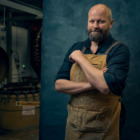Research and Development: Paper moulds
Table of Contents
What was the problem?
Barex 210 was a thermoplastic critical to our process for moulding 3d acrylic forms in small batch production. Between the years of 2009 and 2015, Midton made significant advancements in the application of our moulding technology through the expanded use of this key raw material. In this time, we progressed from basic geometric shapes such as cubes, cuboids, pyramids, and domes, to full 3d sculptures and multi-part moulds.
In late 2014, however, information was published indicating that Barex 210 was no longer patent protected, with various smaller companies across the globe publicly seeking to fill supply demands. Yet, this replacement would have a minimum of a 3 year development period. In April 2015, Midton made their final stock purchase of this material that under normal circumstances would last them a maximum of 3 years.
To combat this problem, we launched a research task in 2015 to find an alternative product that would ideally replace, or at least reduce, the usage and extend the stock life. Barex was also not recyclable, creating a landfill waste issue and creating the added opportunity to reduce environmental impact.
What were the technological advancements made through this research?
- Adoption of new moulding material, normally used in the food industry.
- A move from 0% recyclable to 100% recyclable moulding material for basic geometric shapes (cubes, cuboids and prisms).
- Reduction in moulding costs and preparation time.
- Deep understanding of the limitations of new material in relation to our processes and goals.
- Alterations in production methods and procedures to meet the opportunities and limitations of new card material.
Why did this research take place?
The acrylics casting industry, outside of sheet casting (Perspex), is a small, specific, and closed niche. There is little in the way of knowledge exchange or transparency of process, with small, incremental developments in method providing USP or differentiator between companies.
Firstly, we have set out to achieve a successful casting through a new means. From this, we have defined a reliable process that has allowed us to enable a mass-reproduction of this achievement. In doing so, Midton has developed a multi-layered process that includes many necessary steps to produce consistent results.
What were the scientific or technological uncertainties?
At the time, the use of Barex 210 thermoforming material in the acrylic casting industry was, as far as we know, unique to Midton. We had no knowledge of materials suitable to replace Barex as a moulding material.
Barex 210 was predominantly used in packaging, particularly in the medical and pharmaceutical industry. Commonly used for making blister packs for pills, Barex is renowned for creating a highly durable barrier to the environment. The benefits the material provided us was a combination of chemical resistance, forming ability, and surface adhesion to the acrylic material. Therefore, there was no guarantee that an industry replacement would satisfy the needs of Midton’s process, with the requirements of target industries differing.
In the late 1990s, we tried several types of thermoplastics, prior to finding Barex. These materials had little in the way of success, with reported ‘clouding’ within clear material, or at best, having no surface adhesion. In this situation, where a suitable replacement couldn’t be found, we had no secondary moulding method that could efficiently ease the reliance on Barex 210.
Overcoming Uncertainties
- Sourcing alternative thermoplastic
Midton conducted research around the Barex material and its developer Ineous. Research consisted of online study and discussion with suppliers and resin processors. The aim of this search was gaining as much knowledge and understanding of the material, its characteristics and its uses.We then reached out to our partners in the Netherlands who have strong links with China. The purpose of this line of inquiry was to see if we could find alternate suppliers or recyclers of the product. Several parties came forward claiming to produce similar or cheaper products, coated with the barex resin. Unfortunately, none of these solutions were viable.Inhouse sourcing provided potential material developers and manufacturers in the States, Europe and Australia that specialise in thermoplastics for the medical packaging industry. Samples arrived over a period of around 8 weeks and material sampling continued for several months without a significant find. Results were varied, including the material becoming stuck solid to the acrylic, shrivelling, lack of sufficient detail in the forming process. Our most successful attempt performed well in most aspects, but released a milky residue into the clear acrylic. - Revisiting other known moulding materials
Sheet Metal: Sheet metal box moulds were common use at Midton for large castings. The sheet method is limited to basic geometric shapes that can be constructed from individual panels or rolled sections. These trials revealed issues with precast assembly time, post cast de-moulding, clean-up process, and storage..Cellophane wrapped MDF: Cellophane was a longstanding method for large geometric shapes. Sheet material was wrapped in cellophane, with the wrapped pieces assembled into a box. This method is applied throughout the industry. Preparation time recorded during trials was longer than that of the sheet metal samples and the resulting casts were poorly formed.Mould materials for resins such as rubbers and vinyls were experimented with in the past, requiring additional surface treatment. This proved unsuitable for volume production. - Coating substrates
This took place in the form of in-house experiments. Our experiments in cellophane wrapping led us to consider laminating a card substrate to provide a cheap solution for basic shapes.These trials were conducted using card substrate, a hot laminator, and a laser cutter to make a box. The cardboard box concept was a success, however the acrylic adhered to the surface, making it impossible to de-mould.A second round of trials were conducted, this time using cellophane spray mounted onto the card, and then laser cut. The casting tests using this method were more successful, providing a clean surface with minimal deformation. The quality of form within this card box was a significant improvement to Barex moulds, which had become the accepted norm. Thermoformed moulds require draft angles, and when formed over shapes with large flat faces, become weak, resulting in deformation in the casting.Several sample boxes were prepared following this, laminated with cellophane and distributed to card suppliers, looking for an off the shelf solution. An extensive number of sample sheets arrived. Card used for cake boxes was a common suggestion, however, the card was too weak, and the coating was ineffective.Our first proper lead came through our box supplier, who had picked up a sample of a silicone coated card at a trade show. This product was designed as an eco-friendly solution for ready meals, such as lasagne, that require oven cooking. The product was available in two weights, and two coatings – high and low temperature. Moreover, the box design sample the supplier had was cut to contain liquid without leaks. Working with this box supplier, we conducted tests of the silicone coated product, producing positive results. The material was corrugated, leaving an imprint in the cast material, which wasn’t ideal. The heavy weight material’s high temperature coating, however, meant the cast could be demoulded easily, and averaged 3-4 castings before breaking down.

4. Creating the box design
Initial tests were conducted using the water tight concept on a 100mm cube box. The assembled box, however, didn’t produce a square form due to the excess material required in the folds.
We then designed variations on this concept, taking into consideration the viscous consistency of acrylic slurry. This aided in the improvement of the form and ease of box construction. Issues of box strength were raised by the machine team, who were keen to improve on the deformed Barex moulds.
In order to create a stronger box, there were two significant design changes:
- Lugs/flaps were designed into the box at the top, folding over to create a rigid frame at the aperture of the box
- The orientation of the corrugation was altered, working diagonally across the sides of the box net, therefore reducing the likelihood of collapse
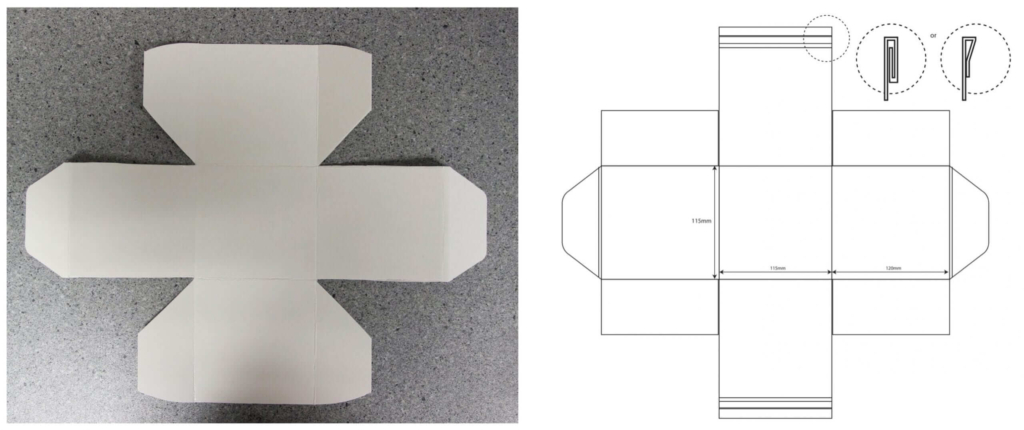
5. Extensive testing
Following the design phase, we continued to work with our box supplier in Edinburgh to begin an extensive round of testing.
While small batch samples had been provided for initial testing, tooling was required to conduct tests at scale. Utilising the box structure designed for the 100mm cube, we had tools manufactured for 10 box sizes over a 6 month period.
Tests were conducted on each size of box while varying the acrylic mix, bench time, curing time, varied coloured mix, and with embedded items. All these factors tested can cause significant issues in processing.
These casts were machined, finished, and reviewed at each stage of production, raising the following issues:
- Box strength: Boxes with sides longer than 120mm were not sufficiently strong enough to hold the volume of acrylic slurry without deformation occurring.
- Box height: Casting demoulded better when the acrylic was cast to 5mm below the top edge, prolonging the mould life. The current box design couldn’t produce the desired finished height with this casting method.
- Bench time: During casting, when subjected to long bench times pre-curing, the surface becomes covered in small bubbles upto 5mm deep into the casting. This cured result was soft to this depth, and fine beyond. This was thought to be a reaction to the silicone.
- Assembly: All the boxes need to be assembled. An opportunity was identified to reduce the time of this through sourcing of various tapes and adhesives.
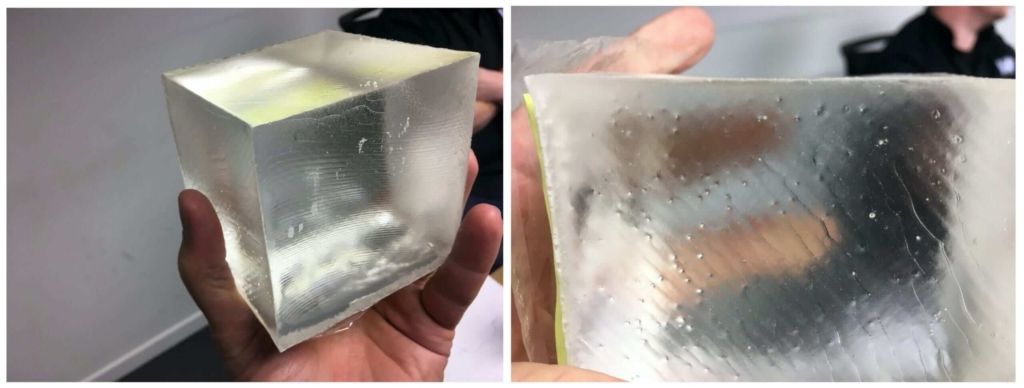
6. Solutions
- Support Rings: Support rings were created to focus on improving the box strength, with 3-4 variations designed. These rings held the boxes in shape, ranging from basic cardboard trays (such as those used to hold drinks), to laser cut acrylic frames with a hinged aluminum bar. Laser cut frames ranked more highly, with a simple application and easy manufacture.
- Revised/Remade Tooling: Adjustments were required to box cutting tools in order to solve this issue and take advantage of the opportunity to increase mould life.
- Bench time: With further trials and examination, it was discovered that the bubbles and inhibited curing could be resolved by closely managed bench times of basic cubes and cuboids. Experiments with prisms found that the thin sections at the ridge of a prism were particularly vulnerable and required curing within an hour of pouring.Limitations to bench time are common to a lot of print work and material embedment at Midton. However, it creates increasing pressure to run a great deal of work simultaneously, in order to close the curing chamber within safe time periods. This significant volume of material, that will potentially be cast in this method, has led to further investigation into quick curing solutions and autoclave rotations.
- Assembly: We worked with suppliers to source quick bonding solutions for the boxes including: dot guns, hot glue, double sided tape, and both paper and plastic tapes. A combination of 3m double sided tape and a single strip of masking tape provided results that were quick and remained firm for multiple castings
Current state of the project.
Silicone coated cardboard boxes are currently in daily use here at Midton. We stock twelve box shapes and hold material to test new designs and unusual small batch shapes. The introduction of the silicone-coated material has generated several offshoot projects that utilise the non-stick qualities of the surface coating.
In addition, we have confirmed that this material is recyclable with paper and have seen a significant reduction in the waste product produced. Our remaining Barex supplies are projected to last for 4.5 years, proving a 50% reduction in use during three years of growth. Our cost per mould has also seen an overwhelming decrease by over 60%.

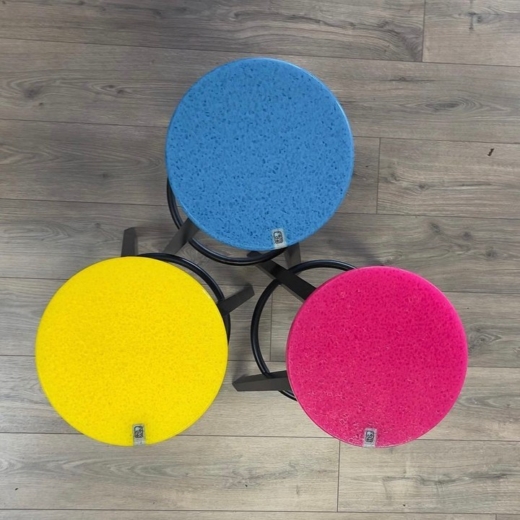
Can Acrylic be Recycled? Introducing Remade
In today's world, sustainability is becoming increasingly important as we realise the negative…
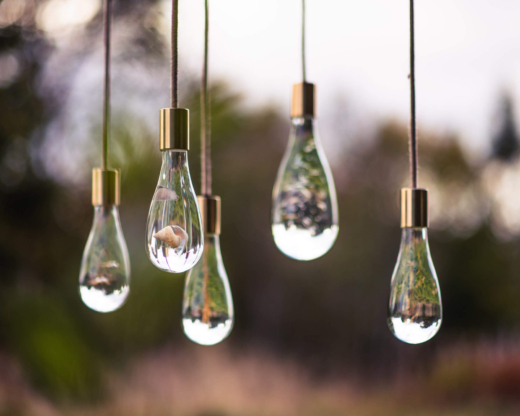
BDNY 2022
Join us at stand 1373 at this years Boutique Design New York (BDNY) conference where we will be…
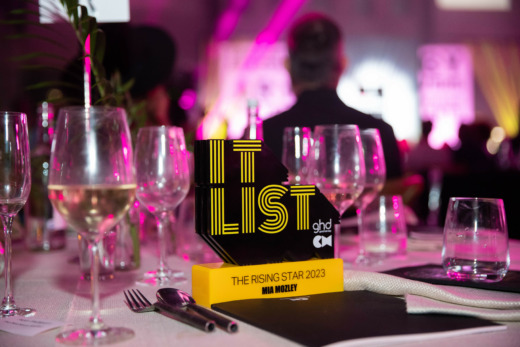
Reflecting on Trends and Anticipating the Future: A Year in the Awards Industry and What’s Ahead in 2024
The landscape of awards ceremonies and recognition programs has evolved significantly over the past…
